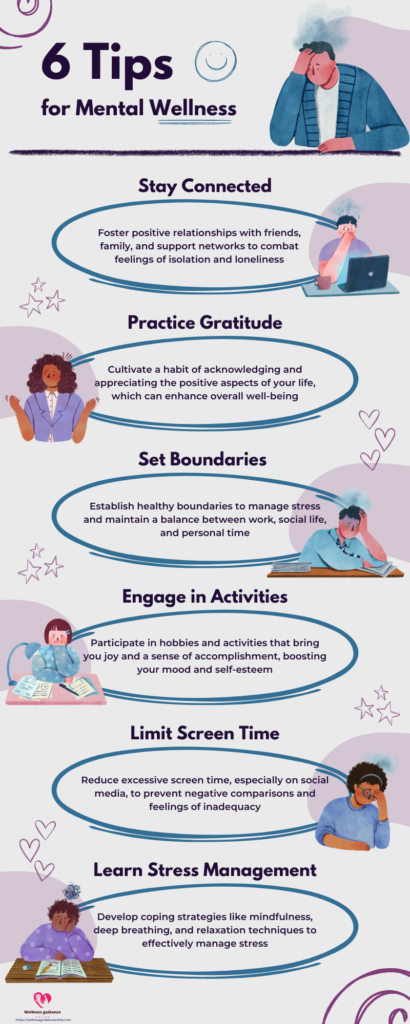Feeling overwhelmed or stressed? You’re not alone. Prioritizing mental wellness is crucial in today’s fast-paced world. This article offers 6 actionable tips to boost your mood, reduce stress, and cultivate inner peace. Check out the accompanying infographic for a visual guide to these practices. Ready to take control of your mental wellness? Let’s dive in!
Understanding Mental Wellness

I believe that mental wellness is crucial for overall well-being. Here are some key points to help you understand mental wellness better:
- Mental Health vs. Mental Illness: Mental wellness is not just the absence of mental illness. It encompasses a spectrum ranging from thriving mentally to struggling with severe conditions. It’s essential to recognize that mental health is dynamic and can fluctuate.
- Factors Influencing Mental Wellness: Various factors impact mental wellness, including genetics, childhood experiences, environmental stressors, and lifestyle choices. Understanding these influences can help in cultivating a healthier mindset.
- Emotional Regulation: Being able to regulate emotions plays a significant role in mental wellness. It involves recognizing and managing feelings effectively, allowing for healthier interactions and responses to challenges.
- Self-Care Practices: Engaging in self-care activities is vital for mental wellness. Whether it’s exercise, mindfulness, creative outlets, or social connections, finding what rejuvenates your mind is key to maintaining balance.
- Seeking Support: It’s okay to seek help when needed. Whether from friends, family, or mental health professionals, reaching out for support is a sign of strength, not weakness.
- Stigma Surrounding Mental Health: There is still stigma associated with mental health struggles. Understanding that seeking help is a brave and necessary step can help break down barriers and encourage open conversations.
Understanding mental wellness is an ongoing journey that requires self-awareness, compassion, and the willingness to prioritize mental well-being. By gaining insights into the complexities of mental health, we can nurture a more resilient and balanced way of living.
Tip 1: Stay Connected
I prioritize staying connected with others to enhance my mental wellness. Here are some strategies I follow:
- Maintain Relationships: I make an effort to nurture my relationships with family, friends, and colleagues. Regular communication helps me feel supported and connected.
- Socialize Regularly: I schedule social activities to interact with others consistently. Whether it’s grabbing a coffee with a friend or attending a social event, these interactions help boost my mood.
- Join Groups or Clubs: Being part of a group or club with shared interests allows me to connect with like-minded individuals. It promotes a sense of belonging and provides opportunities for social engagement.
- Use Technology: I utilize technology to stay connected, especially when face-to-face interactions are not possible. Video calls, messaging apps, and social media platforms help me maintain connections with others.
Remember, staying connected with others is essential for mental well-being. I strive to prioritize these connections to improve my overall mental wellness.
Read: Managing Stress and Anxiety Through Nutritional and Lifestyle Changes
Tip 2: Practice Gratitude
As I navigate my mental wellness journey, I have found that practising gratitude is a powerful tool. Here are some ways I incorporate gratitude into my daily routine:
- Gratitude Journal: I dedicate a few minutes each day to jot down things I am grateful for. This simple practice shifts my focus to positive aspects of my life.
- Mindful Moments: Taking a moment to appreciate the small things, like a warm cup of tea or a beautiful sunset, can cultivate feelings of gratitude.
- Express Thankfulness: I make an effort to express thanks to those around me. Whether it’s a friend, family member, or colleague, showing gratitude creates a positive connection.
Remember, cultivating a mindset of gratitude takes time and practice. However, the benefits are immense. As I continue to integrate gratitude into my daily life, I find that my overall mental wellness and outlook on life improve significantly.
Tip 3: Set Boundaries
Setting boundaries is crucial for maintaining good mental health. It’s important to learn how to say no without feeling guilty and to prioritize your well-being. Here are some strategies that can help you set boundaries effectively:
- Learn to say no: Don’t be afraid to decline requests or invitations that will overwhelm you or compromise your mental wellness. It’s okay to prioritize yourself.
- Identify your limits: Understand what you can and cannot handle. Knowing your limits will help you set boundaries that protect your mental health.
- Communicate openly: Express your needs and boundaries clearly to those around you. Effective communication is key to setting and maintaining healthy boundaries.
- Take time for yourself: Make self-care a priority. Schedule regular alone time to relax, recharge, and focus on your mental well-being.
Setting boundaries is not selfish; it is an essential aspect of self-care. By setting limits and prioritizing your needs, you are showing respect for yourself and taking control of your mental wellness.
Tip 4: Engage in Activities
Engaging in activities is crucial for enhancing mental wellness. When I participate in activities that I enjoy, it helps me relax, unwind, and refocus my mind. Here are some activities that can benefit your mental health:
- Exercise: Physical activity releases endorphins, which are known to improve mood and reduce stress. Whether it’s going for a run, practicing yoga, or simply taking a walk, regular exercise can have a positive impact on my mental well-being.
- Artistic pursuits: Engaging in creative activities such as painting, drawing, or playing a musical instrument can be therapeutic. These activities allow me to express myself, channel my emotions, and promote a sense of accomplishment.
- Mindfulness practices: Mindfulness activities like meditation, deep breathing exercises, or practicing gratitude can help me stay present and calm my mind. These practices promote relaxation and help reduce anxiety and negative thoughts.
- Social interactions: Spending time with friends and loved ones can boost my mood and provide a sense of connection and support. Whether it’s having a meaningful conversation, going for a coffee, or participating in group activities, social interactions play a vital role in my mental well-being.
Engaging in these various activities can have a significant impact on my mental wellness. It’s essential to make time for activities that bring joy and fulfillment to my life, as they can help me manage stress, improve my mood, and support overall mental well-being.
Also Read: Harnessing the Power of Mindfulness for a More-Centered Life
Tip 5: Limit Screen Time
I have found that limiting screen time has greatly benefited my mental wellness. Here are some ways you can try to reduce your screen time:
- Set Boundaries: Establish specific times during the day when you will not use any electronic devices. This could be during meals, before bedtime, or first thing in the morning.
- Use Screen Time Tracking Apps: There are apps available that can help you monitor how much time you spend on your devices. This awareness can be eye-opening and motivate you to cut back.
- Engage in Screen-Free Activities: Find hobbies or activities that do not involve screens, such as reading a book, going for a walk, or practicing a new hobby.
- Create Tech-Free Zones: Designate certain areas in your home, like the bedroom or dining room, as tech-free zones to encourage more face-to-face interaction and relaxation.
- Set Realistic Goals: Gradually decrease your screen time instead of going cold-turkey. Set achievable goals like reducing screen time by 30 minutes each day until you reach a comfortable level.
By limiting screen time, you can reduce eye strain, improve your sleep quality, and increase your productivity. Give it a try and see the positive impact it can have on your mental well-being.
Tip 6: Learn Stress Management
I believe that stress is a common obstacle in today’s fast-paced world, and learning how to manage it is crucial for mental well-being. Here are some effective strategies that have helped me in dealing with stress:
- Identify Stress Triggers: Recognizing what situations or events trigger your stress is the first step in managing it. Once you know your triggers, you can work on ways to avoid or cope with them.
- Practice Relaxation Techniques: Engaging in relaxation techniques such as deep breathing, meditation, or yoga can help calm both your mind and body, reducing stress levels significantly.
- Exercise Regularly: Physical activity is not only beneficial for your physical health but also plays a vital role in managing stress. Regular exercise releases endorphins, which are known to improve mood and reduce stress.
- Maintain a Healthy Lifestyle: Eating a balanced diet, getting enough sleep, and staying hydrated are simple yet effective ways to support your body in coping with stress.
- Seek Support: Talking to a friend, family member, or mental health professional can provide emotional support and guidance on how to manage stress more effectively.
- Set Boundaries: Learn to say no to tasks or commitments that overwhelm you. Setting boundaries is essential for protecting your mental well-being from unnecessary stress.
In conclusion, learning stress management techniques is a valuable investment in your mental wellness. By taking proactive steps to identify and address stress triggers, practicing relaxation techniques, staying physically active, and seeking support when needed, you can significantly reduce the impact of stress on your mental health.
Incorporating Mental Wellness into Daily Life
I believe that mental wellness is essential for a balanced and healthy life. Here are some practical tips for incorporating mental wellness into your daily routine:
- Start the day with mindfulness: Before diving into your tasks, take a few moments to center yourself through meditation or deep breathing. This can set a positive tone for the day ahead.
- Create a self-care routine: Dedicate time each day to activities that bring you joy and relaxation, whether it’s reading a book, taking a bath, or going for a walk. Prioritizing self-care is crucial for mental well-being.
- Practice gratitude: Take time to reflect on things you are grateful for each day. Keeping a gratitude journal can help shift your focus to the positive aspects of life.
- Connect with others: Social connections are vital for mental wellness. Make an effort to reach out to friends and loved ones regularly, whether through phone calls, video chats, or in-person meetings.
- Set boundaries: Learning to say no and establish boundaries is important for protecting your mental health. Don’t be afraid to prioritize your own well-being.
- Seek professional help when needed: If you are struggling with your mental health, don’t hesitate to seek support from a therapist or counselor. Asking for help is a sign of strength, not weakness.
By incorporating these practices into your daily routine, you can nurture your mental wellness and cultivate a healthier mindset for overall well-being.
Creating a Supportive Environment
Feeling supported is crucial for maintaining good mental wellness. Here are some tips on creating a supportive environment:
- Open Communication: I believe that fostering open communication is key. Encourage honest and transparent conversations with friends, family, or colleagues. This can help create a safe space where you can express your emotions and thoughts without judgment.
- Set Boundaries: Establishing healthy boundaries is essential for maintaining mental well-being. It’s okay to say no to things that may cause you stress or discomfort. Remember, taking care of yourself is not selfish.
- Surround Yourself with Positivity: I find that surrounding myself with positive influences can significantly impact my mental health. Seek out relationships and environments that uplift and inspire you.
- Practice Self-Care: Prioritize self-care activities that help you relax and unwind. Whether it’s meditation, exercise, reading, or spending time in nature, make time for activities that nourish your mind and body.
- Seek Support: Don’t be afraid to reach out for support when needed. Whether it’s talking to a therapist, joining a support group, or confiding in a trusted friend, seeking help is a sign of strength, not weakness.
- Create a Healthy Routine: Establishing a routine that includes sufficient rest, nutritious meals, exercise, and time for relaxation can help maintain mental wellness. A balanced routine can provide structure and stability in your day-to-day life.
Conclusion
I have shared with you six valuable tips that can help in enhancing mental wellness. By implementing these strategies into your daily routine, you can take proactive steps towards taking care of your mental health. Remember to prioritize self-care, engage in physical activity, maintain a healthy diet, practice mindfulness and relaxation techniques, seek social support, and consider professional help when needed.
Incorporating these tips can lead to improved mental well-being, increased resilience to stress, and a more balanced and fulfilling life overall. It is essential to make your mental health a priority and take the necessary steps to nurture your well-being. By making small changes each day, you can make significant progress towards achieving a healthier mind and a happier life.
Always remember that mental wellness is a journey, and it is okay to seek help along the way. With determination, self-awareness, and the willingness to make positive changes, you can cultivate a strong and resilient mind that can navigate life’s challenges with grace and strength. Your mental health matters, so make sure to prioritize it every day.
Download the Infographic
Download printable, high-quality PDF infographic


